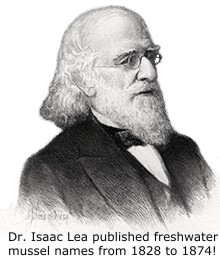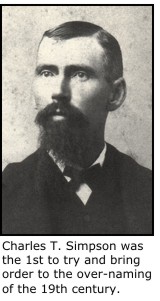| Page last updated
28 December 2007 |
 Ten Malacologists are Responsible for Over Half of the Names Appplied to Freshwater Mussels! Ten Malacologists are Responsible for Over Half of the Names Appplied to Freshwater Mussels!
The over-naming of freshwater mussels can be attributed to two classes of factors: the extreme variability of wide ranging species and extreme splitting by certain authors. The latter of these simply the result of individual abilities for making up new names.
The First-Place Grand Champion of unionoid (as well as freshwater mollusks, generally) naming is Dr. Isaac Lea of Philadelphia (b. 1792, d. 1886). Lea received specimens from not only the United States but the whole world, and he published names, descriptions and beautiful illustrations of freshwater mussels for more than 45 years. Lea alone introduced about 20% of freshwater mussel names.
Other authorities shared Lea's desire to name the various components of unionoid diversity, and the top 10 are listed in the table below. The number of available and valid names are from Haas (1969), the last comprehensive treatment of freshwater mussel species. As can be seen, although Dr. Lea introduced many more names than the Europeans following him on the list, a greater proportion of his names continued to be applied as valid.
| Malacologist |
Nationality |
Available |
Valid |
| Lea, I. |
American |
838 |
236 (28%) |
| Locard, A. |
French |
339 |
1 (0%) |
| Bourguignat, J.R. |
French |
311 |
12 (4%) |
| Drouet, H. |
French |
156 |
7 (4%) |
| Kobelt, W. |
German |
144 |
3 (2%) |
| Heude, R.P. |
French |
124 |
28 (23%) |
| Conrad, T.A. |
American |
102 |
56 (55%) |
| von Martens, E. |
German |
89 |
30 (34%) |
| Rafinesque, C.S. |
French/American |
84 |
32 (38%) |
| Sowerby, G.B. |
British |
63 |
12 (19%) |
| Total |
|
2250 |
417 (19%) |
| According to Haas (1969), there are 4178 available freshwater mussel nomina. Over half (54%) of these where named by ten authors. One telling statistic is the percent of their names that are valid— the overall synonymy rate is about 5:1, so percentages in the table of less than 20% suggest an even more outrageous degree of over-naming. |
|
 |
The difficulties of trying to make sense of the late 19th century French School of malacology have been evident from the get-go. Locard & Bourguignat introduced so many invalid names that few have managed a comprehensive synonymy of the European freshwater mussel fauna. As Simpson (1900) put it:
"One of the most perplexing problems has been the work done by European conchologists, and especially by the so-called new school of France. Previous to 1870... thousands of names had been applied to the few species of Europe. But this work was conservative and reasonable compared with that of the new school since then. I have devoted much time and study to this fauna and its literature. To me it seems that there are not more then eighteen or twenty species of Unionidae found in Europe, judging by the same standards I have applied to species elsewhere. Nearly all the authors seem to be more or less out to sea as to certain forms of this area, and the reasons for this are probably their want of striking characters and their extreme variability."
|
Simpson was especially frustrated by Locard, number two on the list of all-time over-namers.
"In 1892 Arnould Locard, one of the great lights of the new school, stated that there were 208 species of Unios and 250 Anodontas in France alone. Life is too short and valuable to be wasted in any attempt at deciphering such nonsense, and I have not even cumbered the pages of this work with a list of these new species. Those interested can find them in the works of Westerlund and Kobelt."
References
- Simpson, C.T. 1900. Synopsis of the naiades, or pearly fresh-water mussels. Proceedings of the United States National Museum 22(1205): 501-1044.
- Haas, F. 1969. Superfamilia Unionacea. Das Tierreich (Berlin) 88. 663 pp.
|